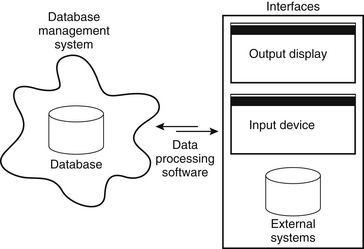Chapter 29 Data Management
Building a Successful Outcomes Information System
The database itself is but one component of an efficient scheme for data collection, storage, and retrieval. At this point it is necessary to highlight a crucial aspect of understanding outcomes information systems (outcomes systems). The word system is used here to accent the simple distinction between the data “store,” or database (i.e., the electronic data storage mechanism), and its functional environment. Although each system typically has a database at its core that is responsible for data storage, the overall system is much broader, including database management software, data processing software, presentation applications (i.e., browsers), user interfaces (i.e., input and output screens), and the hardware on which it operates (Fig. 29-1). The term database simply refers to the data storage mechanism. Within the context of an overall information system, the database can perform properly, but the database is entirely useless outside of the system. Ideally, a well-designed database drives the development of its interrelated technical components (i.e., hardware and software), resulting in an efficient and elegant solution for outcomes research.
This discussion is intended to help bridge the divide between individuals who desire a medical outcomes information system and those who possess the knowledge and skills to build and maintain it. There is often a significant gap between the perceived resource requirements, in terms of time, technology, and human resources, the creation of such a system, and the actual requirements. This is especially true with respect to the time necessary for design and development. However, effective communication between the users and the technical staff (i.e., the individuals commissioned to build and maintain a system) can drastically shorten the development cycle. Therefore, here this relationship is analyzed throughout all of the system development stages, beginning with the initial conceptual development and finishing with implementation. The system development process is deconstructed into three key stages: definition, design, and deployment.
System (Project) Definition
Determining Data Elements
Beyond the selection process, all of the data elements must be presented in a standardized and concise manner that can be readily adopted by all of the system participants (patients and health care providers). For provider-entered data elements, standardizing the terms used to describe spinal disorders and their manifestations is necessary to allow accurate categorization of patients within each specific disorder. This standardization process is essentially the process of establishing the common language that is subsequently used by all participants. Health care providers will use it to describe their patients, patient symptoms, pathologies, treatment options, and the course of therapy. For patient-reported data, using validated scales and questions that are at the appropriate education level is good practice and optimizes the accuracy of the information.








